#i love giovanni de medici
Text

Giovanni
#hes the most kind and innocent character 🥹#just look at him#i love giovanni de medici#cesare posting#cesare manga#cesare reading
0 notes
Text
I love finding historical portraits that look like characters. It's useful for referencing, but also fun for pretending that these portraits of nations are lurking around in museums and nobody is the wiser. I found this ages ago, but every time I see it I am thrown for a loop
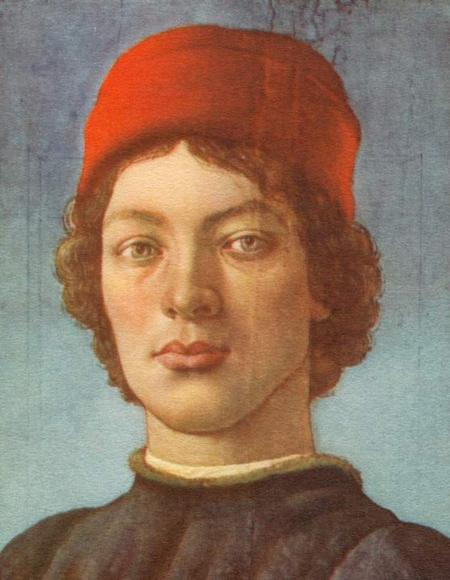
Mr. Feliciano Vargas is that you??? Serving the 1490s specials?? For us?
#hetalia#historical hetalia#my thoughts#hws italy#hws veneziano#this is actually a portrait of giovanni il popolano de medici#i found it when i was looking into caterina sforza (he was one of her husbands) and i was shook#i can't be the only one who finds that resemblance uncanny#that post about historical male love interests reminded me of this
85 notes
·
View notes
Text
BROTHERS IN MEDICI DESERVE BETTER



#you cant tell me they didnt love one another#fight me history#giovanni di lorenzo de medici#piero di lorenzo de medici#lorenzo#lorenzo the magnificent#lorenzo the elder#cosimo#francesco pazzi#guglielmo de pazzi#giuliano de medici#i medici
67 notes
·
View notes
Text
THIS DAY IN GAY HISTORY
based on: The White Crane Institute's 'Gay Wisdom', Gay Birthdays, Gay For Today, Famous GLBT, glbt-Gay Encylopedia, Today in Gay History, Wikipedia, and more … April 20



1188 – Died: St Hildegonde of Neuss (Also spelt Hildegund), German saint, biologically female, who dressed as a boy as a child, and lived as a man as an adult, before entering a male monastery. She was born at Neuss, near Cologne. After the death of her mother, at age 12, she went with her father, a knight, on a pilgrimage to Jerusalem. For her safety, during the trip, she was dressed as a boy and called "Joseph" for her protection.
While returning from the Holy Land Hildegund's father died, but she was able to make her own way home and maintained her disguise first as a boy and then as a man. Later, she made a pilgrimage to Rome, during which she had several adventures.
On one of them, she was condemned to be hanged as a robber and escaped only when a friend of the real robber cut her down from the gallows.
After that, she returned to Germany and was accepted into the Cistercian monastery at Shönau, near Heidelberg, concealing her gender, and to her death she was believed to be a man. Her true sex went undiscovered until her death in 1188.
A few years later, abbot Engelhartof Langheim wrote her biography. She is considered a saint, even though her cult is not approved by the Roman Catholic Church.


Aretino by Titian
1492 – The Renaissance writer and dramatist Pietro Aretino was born on this date (d.1556). Aretino was an Italian author, playwright, poet and satirist who wielded immense influence on contemporary art and politics and invented modern literate pornography, notably in La Cazzaria ("The Book of the Prick"). This colorful writer and dramatist, described as the first professional writer of his century, was probably the son of a cobbler, although he preferred to claim he was illegitimate and of noble origin. His patrons included Popes (Leo X, Clement VII), Cardinals, kings (Francois I and Emperor Charles V) and other connoisseurs of the porn of the age. He had a flair for self-dramatization, a fertile dirty mind, and an uncanny knack for profiting from the politics of his age. He first achieved notoriety for a series of pornographic sonnets, each describing a different position of sexual intercourse, and each illustrated by Giulio Romano and in which he declares himself to have been a sodomite from birth.
Aretino prospered, living from hand to mouth as a hanger-on in the literate circle of his patron, sharpening his satirical talents on the gossip of politics and the Papal Curia, and turning the coarse Roman pasquinade into a rapier weapon of satire, until his sixteen ribald Sonetti Lussuriosi (Lust Sonnets) written to accompany Giulio Romano's exquisitely beautiful but utterly pornographic series drawings engraved by Marcantonio Raimondi under the title I Modi finally caused such outrage that he had to temporarily flee Rome.
In 2007, Michael Nyman set eight of the poems to music. They proved no less controversial in the twenty first century: at a 2008 performance at Cadogan Hall, the programs were withdrawn on allegations of obscenity.
In a letter to Giovanni de Medici written in 1524 Aretino encloses a satirical poem saying that due to a sudden aberration he has fallen in love with a female cook and "temporarily switched from boys to girls..." Later he was known and admired for his ragionamenti dialogues, often audaciously filthy, on contemporary Roman life. Public figures so feared his clever and vicious pen that Aretino became rich from promising not to write on certain subjects. He is said to have died from a stroke while laughing at a dirty joke.
Aretino was a close friend of Titian, who painted his portrait at least three times. The early portrait above is a psychological study of alarming modernity.


1857 – Herman Bang (d.1912) was a Danish writer and one of the men of the Modern Break-Through - the late 19th century literary movement in Scandinavia that replaced Romanticism. Bang was born of a noble family on the small Danish island of Als.
When he was twenty he published two volumes of critical essays on the realistic movement. In 1880 he published his novel Haabløse Slægter (Families without hope), which at once aroused attention. The main character was a young man who had a relationship with an older woman in Danish fin de siècle society. The book was considered pornographic and immoral at the time and was banned. After some time spent travelling and a successful lecture tour in Norway and Sweden, he settled in Copenhagen, and produced a series of novels and collections of short stories, which placed him in the front rank of Scandinavian novelists. Among his more famous stories are Faedra (1883) and Tine (1889).
Bang was a homosexual, a fact which partly isolated him in Danish cultural life and made him the victim of smear campaigns. He lived most of his life with his sister but found happiness for a few years with the Hungarian actor Max Eisfeld with whom he lived in Prague 1885-86.
Failed as an actor, Bang earned fame as a theatre producer in Paris and in Copenhagen. He was a very productive journalist, writing for Danish, Nordic and German newspapers, developing modern reporting. His article on the fire of Christiansborg Palace is a landmark in Danish journalism. Some of his books, including Tine and Katinka (English titles), were translated into many languages and filmed.
Of especial interest is Michael. Michael (also known as Mikaël, Chained: The Story of the Third Sex, and Heart's Desire) was a movie released in 1924 directed by fellow Dane Carl Theodor Dreyer (director of other notable silents such as The Passion of Joan of Arc (1928)). Along with Different From the Others (1919) and Sex in Chains (1928), Michael is widely considered a landmark in gay silent cinema.
The film is based on Herman Bang's 1902 novel Mikaël. It is the second screen adaptation of the book, the first being The Wings, made eight years prior by gay director Mauritz Stiller. Michael, however, follows Bang's storyline much more closely than the earlier film version had done.
Herman Bang's last years were embittered by persecutions and a declining health. He travelled widely in Europe and died during a recitation tour in the USA.


1895 – Henry de Montherlant was a French writer of essays and novels (d.1972), as well as one of the leading French playwrights of the twentieth century.
Descended from an old noble family, he was educated at private schools at Jeanson-de-Sailly, then at the Sainte-Croix academy at Neuilly-sur-Seine, where his family lived.
Conscripted in 1916, he was wounded and decorated. Marked by his experience of war, he wrote Songe (Dream), an autobiographic novel, as well as his Chant funèbre pour les morts de Verdun (Funeral Chant for the Dead at Verdun), both exaltations of heroism during the Great War.
His early successes were works such as the tetralogy Les jeunes filles (The Young Girls) (1936-1939) and Les célibataires (The Bachelors) (1934). At this time he did a lot of travelling, mainly to Spain, Italy, and Algeria.
From 1929 he began to write for the theatre, plays such as La reine morte (1934), Pasiphaé (1936), Le Maître de Santiago (1947), Port-Royal (1954), Le Cardinal d'Espagne (1960). He is particularly remembered as a playwright. In his plays, as well as in his novels, he frequently portrayed heroic characters displaying the moral standards he professed.
In Le solstice de Juin (1941) he expressed his admiration for the German army and claimed that France had been justly defeated and conquered in 1940.
Montherlant concealed his pederastic tendencies from the public during his lifetime. In 1912, he had been expelled from the Sainte-Croix de Neuilly academy for a relationship with a fellow student. Although not openly gay, Montherlant treated homosexual themes in his work, including his play La Ville dont le prince est un enfant (1952) and novel Les Garçons (The Boys), published in 1969 but written four or five decades earlier. Les garçons and his correspondence with Roger Peyrefitte, (author of Les amitiés particulières (1943), also about sexual relationships between boys at a Roman Catholic boarding school), are the main testaments to this side of his character.
In 1960 Montherlant was elected a member of the Académie française. His presentation speech dwelt mercilessly on the geography of New Zealand.
According to Peyrefitte, some time in 1970 he was beaten up by some youths, which caused a serious injury to his eye, as a consequence of which he became progressively blind.
He committed suicide in 1972, swallowing a cyanide capsule and shooting himself in the head.

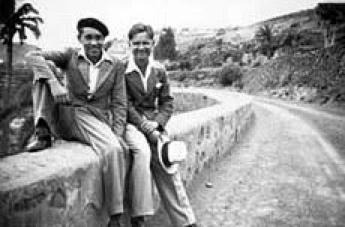
Isherwood and Neddermeyer
1914 – Heinz Neddermeyer was a German citizen considered to be the first great love of writer Christopher Isherwood.
Heinz and Christopher met in Berlin on March 13, 1932 when Heinz was 17. Christopher would often describe their relationship as an adoption, since Heinz was so much younger and not entirely mature. The couple lived together in Berlin until May 1933 when, because of the rise of Hitler, they were forced to flee the country. They traveled Europe and North Africa until May 12, 1937 when Heinz was expelled from Luxembourg and forced to return to Germany. The next day he was arrested by the Gestapo and sentenced to three and half years of forced labor and military service. He survived the forced labor which was brief. Being conditionally freed if he would take a wife, he married a woman named Gerda in 1938 and had a son named Christian, his only child, in 1940. It was not uncommon for gay men to take this drastic turn in their lives after being arrested and sentenced to prison for homosexuality by the Nazi party.
Although Heinz and Christopher continued to correspond, Heinz would not see Christopher again until November of 1952 while Christopher was visiting England and Germany for productions of his "Berlin Stories".
In November 1956 Christopher received a note from Heinz stating that he had been in a political argument at the factory where he worked in East Berlin. Fearing arrest, he fled to Hamburg. Christopher sent him some money. Nothing else is mentioned of Heinz in Christopher's diaries other than fond memories of their past in various cities around Europe and a kind note from Heinz when Christopher's mother passed away in August of 1960.
Heinz died in 1984.


1935 – Warren Casey (d.1988) was an American theatre composer, lyricist, writer, and actor. He is best known for being the writer and composer, with Jim Jacobs of the stage and film musical Grease.
In the mid-1960s, Casey met Jim Jacobs while acting with the Chicago Stage Guild, and the two began collaborating on a play with music about high school life during the golden age of rock 'n' roll in the 1950s. Entitled Grease, it premiered in 1971 at the Kingston Mines Theater, one of the pioneering companies of Chicago's off-Loop theater movement, in the Lincoln Park section of Chicago. Producers Ken Waissman and Maxine Fox saw the show and suggested to the playwrights that it might work better as a musical, and told them if the creative partners were willing to rework it and they liked the end result, they would produce it off-Broadway.
Casey quit his day job as a department store lingerie buyer and the team headed to New York City to collaborate on what would become Grease, which opened at the Eden Theatre in downtown Manhattan, moved to Broadway, and earned him a Tony Award nomination for Best Book of a Musical. The show went on to become a West End hit, a hugely successful film (for which he and Jacobs wrote additional songs), and a staple of regional theatre, summer stock, community theatre, and high school drama groups.
Casey was gay and he died of AIDS-related complications in Chicago at the age of 53. At the time of his death he was writing a musical with the Brazilian performer Valucha deCastro.


1943 – Jamie Gillis (d.2010) was an American pornographic actor, director and member of the AVN Hall of Fame.
Gillis was born James Ira Gurman in New York City into a Jewish family and graduated from Columbia University. His parents named him Jamie after the Tyrone Power character in the film The Black Swan (1942), and he took the name Gillis from the girlfriend he was living with when he made his first films.
He appeared in more than 470 movies as an actor. He also directed several adult movies. Openly bisexual, he appeared in many gay porn films, including a sex scene with Zebedy Colt in the 1975 BDSM-themed film The Story Of Joanna. Gillis also appeared in the mainstream Hollywood film Nighthawks (1981) as the boss of Lindsay Wagner's character.
He was a pioneer in the pornographic style known as Gonzo. In addition to starring in the first Buttman film, he also created the influential On The Prowl series. Featuring a porn star who rides in a limo looking for regular guys to have sex with, the video series was very popular and inspired a scene in the movie Boogie Nights. He also co-produced the popular Dirty Debutante series with fellow director and performer Ed Powers, as well as the Walking Toilet Bowl series of films that focused on golden showers and coprophilia.
Gillis died on February 19, 2010 in New York City from melanoma, which was diagnosed four or five months earlier. In an audio interview given to The Rialto Report shortly before his death, Gillis stated that in the 1970s he'd wanted his ashes to be scattered in Times Square, but years later he changed his mind as "clean Times Square would contaminate them".

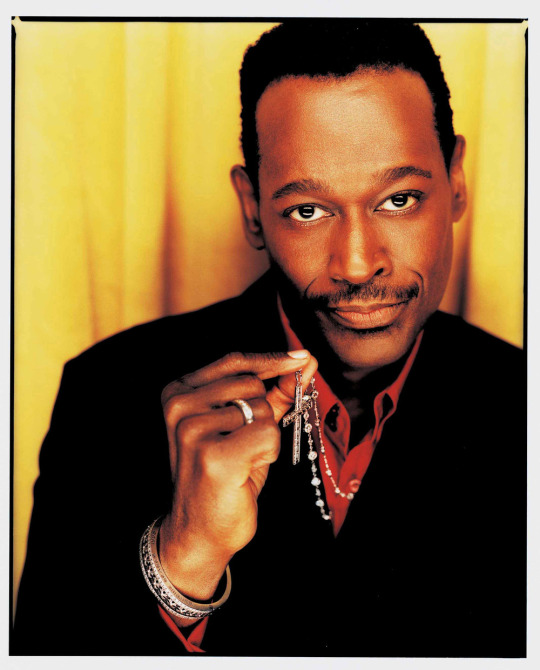
1951 – The American R&B singer Luther Vandross was born on this date (d. 2005).
Initially content to remain in the background as a backing singer and producer - he toured with David Bowie in 1974 and sang backing vocals on the Young Americans (1975) album - Vandross was encouraged to take centre stage by Roberta Flack, who thought he had a unique talent. His breakthrough to major chart success came as lead singer with Change, and he went on to have a string of million selling hit solo albums, and successful collaborations with other artists, throughout the 80s and 90s.
During Vandross' entire career he was 'dogged' by questions regarding his sexuality. He never married, his name was never romantically linked in the media with women. Although Vandross never explicitly denied being gay, he never publicly acknowledged it either. He generally fielded questions by saying that his 'busy lifestyle' made marriage difficult and indicated that, in any case, 'it was not what he wanted.' Many gay publications have stated that Vandross' gayness was an 'open secret' in the music business, but even now it is rarely spoken of.
He died of a heart attack in Edison, NJ at 54. Some of his songs are: Endless Love, Always and Forever, Dance with My Father and Your Secret Love.
His unusual middle name "Ronzoni" was given him by his mother in thanks for the comfort that Ronzoni brand pasta products gave her during her pregnancy.


1959 – Douglas Sadownick is a gay American writer, activist, professor and psychotherapist. He co-created The Buddy Systems (1985) with Tim Miller, with whom Sadownick was involved in a 14-year relationship.
Born in the Bronx, Douglas Sadownick attended Columbia College for his B.A., New York University for his graduate work in English, and the graduate program in clinical psychology at Antioch University for a Master's of Arts in Clinical Psychology. He received his Ph.D. from Pacifica Graduate Institute in Clinical Psychology in 2006. His dissertation was entitled, Homosexual Enlightenment: A Gay Science Perspective on 19th Century German philosopher Friedrich Nietzsche's Thus Spoke Zarathustra.
He is the founding director of the nation's first LGBT Specialization in Clinical Psychology, at Antioch University, and he is also the Founder of Colors LGBTQ Youth Counseling Center, founded in 2011, with Philip Lance, an LGBT affirmative psychologist and community organizer. He is also a co-founding member of the Institute for Uranian Psychoanalysis , which is the first Institute in the world dedicated to deepening homosexual self-realization. He was also a principal co-founder of Highways Performance Art Space in 1989.
His work Sacred Lips of the Bronx (1994) was nominated for a Lambda Literary Award. His second book, Sex Between Men: An Intimate History of the Sex Lives of Gay Men, Postwar to Present, was published in 1996 and 1997. His articles have appeared in the Advocate, the Los Angeles Times, Genre, High Performance, the New York Native, and the L.A. Weekly. He received a GLAAD award for excellence in reporting in 1991. He works as a private practice psychotherapist in Hollywood, California.

McGehee (L) with working partner Siegel


1981 – Matus Valent is a European male fitness model born in Bratislava, Slovak Republic living in California.
As a youth, he played indoor volleyball and became the Junior Slovakian champion with his team ASK Inter. He was also on the Slovakian National volleyball team at age 19.
During his college years, he turned to beach volleyball, and in 2004 he became the California A-Category champion. After earning a University Masters Degree in Physical Education and Sports with Management in his hometown, he moved to California where he now lives.
Matus Valent has appeared in numerous magazines (over 200 in the past 8 years) including Muscle & Fitness, Fitness RX, Flex, Muscle & Performance, Iron Man and many others with over 46 covers in the USA and internationally. He also has several catalog, romance novels & fitness book covers under his belt. (Not to mention his ample goodies)
His modeling career has lead to many other opportunities for Matus, including appearing in the music video for Kristine W's hit " Walk Away," modeling for the movie poster for "Pathfinder", being featured in national advertising for Otomix fitness clothing and active wear, national TV commercial for Shake Weight, TCORE, and ORECK XL vacuums and co-starring in the third season of Janice Dickinson Modeling Agency TV series. In 2009, Matus also appeared in ad campaigns for Prosource.net and Nutrition Express supplements superstores and made appearances in the films "Night at the Museum II" and "Baggage Claim."

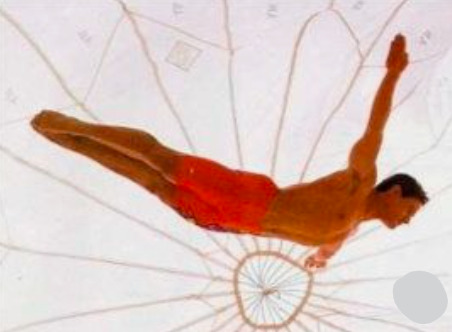
1990 – On this date Queer Nation members showed up en masse at Macy's department store where Olympic gold medalist Greg Louganis was promoting a new swimsuit line. Queers arrived with WHEATIES cereal boxes with the swimmer's picture pasted on front, to recall the time the cereal maker rejected Louganis as a spokesperson, ostensibly because he is Gay.



How to say gay in Chinese
2001 – China removes homosexuality from their list of mental disorders.
Bōlī (玻璃)
The English translation of the Chinese word bōlī (玻璃) is crystal, glass, etc., and since the mid-90s it has been used as a slang term for homosexual men by the LGBT community in China and Taiwan. This slang word comes from the English acronym B.L., which has several versions, like Boy Lover, Boy’s Love, Boys Love. All of them serve to refer to the love between boys, men, etc.

T-shirt with the bōlī (玻璃) drawing.


27 notes
·
View notes
Text
due to my love of all things Cavalcanti and Ficino related, I went on a search for Cavalcanti's home. And la, I found at least what currently exists as the former Cavalcanti estate.

[...] as far back as the Middle Ages the Cavalcanti, a powerful Florentine Guelph family, owned numerous holdings in the locality of Murlo between the Pesa river and its tributary, the Virginio. The old feudal property was destroyed by the Ghibellines after their victory over the Guelphs at the Battle of Montaperti.
What remained of the estate was divided up between various members of the Cavalcanti family, and Lorenzo Cavalcanti undertook the task of reconstruction and improvement, as well as buying back neighbouring land, as recorded in a survey from 1498.
I presume this is the same Lorenzo Cavalcanti who was near Lorenzo de' Medici during the Pazzi Conspiracy and helped to save him from the would-be assassins.


The present structure, commissioned in the early 18th century by the Baldocci family, and was designed by the architect Bernardino Ciurini. Between 1723 and 1740 teams of artists decorated the structure, including the stucco artist, Giovan Martino Portogalli. Also employed were the Bolognese painters Anton Domenico and Giovan Filippo Giarré who executed the frescoed classical landscapes, vedute, in the salons on the ground and first floors. At the south west end, those parts of the villa dating from the 16th century were enlarged, incorporating the old 15th-century workers' house.

The above is an aerial shot of the current villa. Now this isn't what Giovanni would have lived in, but it's a good view of the lands that belonged to the family. No wonder Ficino wrote to Giovanni one time saying something like "I understand why you've not returned to me Florence because where you are is so beautiful."
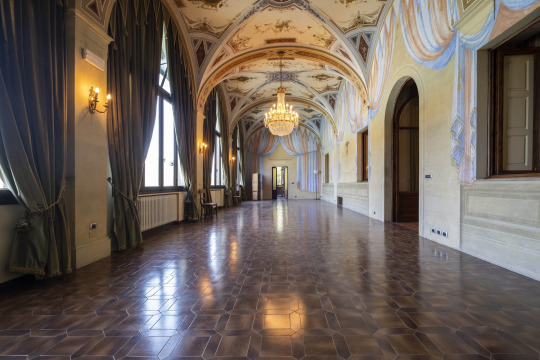

Yeah, I think I could live here happily enough.
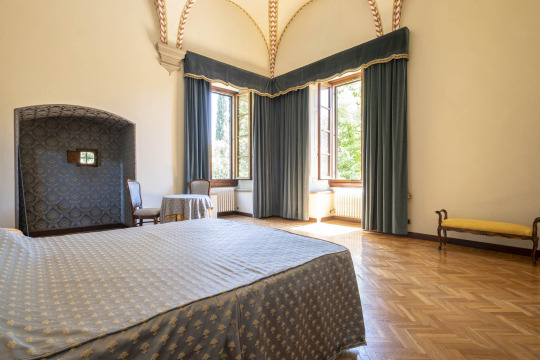
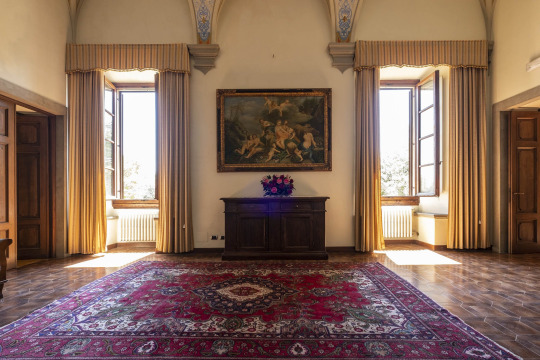
I can see why Ficino was so happy to stay with Cavalcanti for extended durations of time. I'd happily write philosophy if I had some of the views presented from this vantage point.


Now, I'm not sure if Giovanni had access to this specific land and whatever house/palazzo was on it during his lifetime given that the land had been divvied up between family members. But they all were in roughly the same area, so it gives a good idea of what he and Ficino would have been looking at while writing their Very Married We Have A Shared Email Account joint letters to people.
7 notes
·
View notes
Note
What if scenario: Desmond dies and is reborn in AC2 and ends up somehow being betrothed to Claudia instead of Duccio. (Duccio still gets beaten up though lol) Desmond has his memories like in yew branches.
I’m sure there’s going to be at least three people (one of them being Claudia herself) who would joke that he only wants to marry Claudia to finally be Ezio’s brother. XD
Okay, in all seriousness, let’s talk about how this would work.
Betrothals during this era is quite… early. Claudia herself is betrothed to Duccio by the time she is 15 so it won’t be surprising if their betrothal happened when she was 13 or 14.
Now, you mention Yew Branches and I think that we would have an easiest way to make this happen by just kicking Desmond into a canon character that would make sense to be betrothed to Claudia.
Of course, the first target that comes to mind would be one of the Medicis, mainly because that would fortify the alliance between House Medici and House Auditore and Claudia would be marrying ‘up’ but the oldest son of Lorenzo would be Piero and he has an 11 year difference with Claudia and would be 4 when Claudia is 15.
Claudia would definitely complain and say no. Honestly, pre-tragedy Claudia feels like a girl who would be into older men because she’d think they’re sooooo mature and ‘dashing’ and ‘mysterious’. A bit of a hopeless romantic keeping her Auditore audacity at bay.
So…
May I suggest… kicking Desmond into being reborn as Lorenzo’s unfortunate will-die-in-the-Pazzi-conspiracy younger brother, Giuliano?
He would be 8 years older than Claudia but that’s fine. There are larger age gaps in Renaissance Italy (Lucrezia’s 14 year gap with Giovanni Sforza for example) and it would be funny if Claudia is actually attracted to him because he’s cool, strong and sooooo mysterious.
Desmond… Desmond just wants to save everyone, goddammit.
Also… this gives us an excuse for Desmond to have complicated feelings over having Lorenzo as his brother.
If you’re still iffy with the age gap, Lorenzo di Pierfrancesco de' Medici is only 2 years older than Claudia and marrying Claudia to a branch family member of the Medici would be a better move because Lorenzo is trying to lock in the Auditores’ loyalty (and the Assassins’ support) but marrying from the main family seems a bit… ‘wasteful’.
Either way, pre-tragedy Claudia? She’d definitely be attracted to Desmond.
Post-tragedy Claudia? Yeah, she’d cling to Desmond more because she’s so lost but, once she gets her feet to the ground and starts understanding the ‘freedom’ she has in Monteriggioni, she’d probably be the one to break off the engagement (especially if this is Brotherhood!Claudia).
Desmond accepts it but, shit… He can’t believe he’s saying this but…
He…
He might have accidentally fallen in love with Claudia already???
#ezio would definitely be supportive#but also would threaten desmond that he’d kick his ass#if he ever hurts his baby sister#medici or not#desmond’s just like#dude i think claudia would kill me first#and you gotta help her hide the body#and ezio’s offended that desmond would think his baby sister is that viscious but also…#yeeaaaahh#he can see claudia being that viscious#ask and answer#assassin's creed#desmond miles#claudia auditore#ezio auditore#teecup writes/has a plot#fic idea: assassin's creed#claudes#i think that's what i use for their pairing#idk
41 notes
·
View notes
Note
hey emma! what are some cool anecdotes you have learned from studying the link between art and patronage? the more i think about it, the more I realize how it's an invisible part of Art we rarely think or talk about!
I’m sorry I’ve left this unanswered for so long. There are just so many! But honestly what I love about studying (art) history is the really intimate, personal things that appear. Like the other day I read a letter from Clarice Orsini to Lorenzo de Medici relaying how their son, Giovanni (later also X - who I’m writing on now) was very proud that he went to bed on his own and slept through the night. He was probably 3 years old. It’s just so… real. And it doesn’t really have anything to do with what I actually study and won’t be in my paper but it makes these people feel so tangible.
17 notes
·
View notes
Note
i found your blog earlier this week and i love your art! i especially like the way you paint renaissance dress! 💕💕 if it's not rude to ask, where do you find your refs?
Thank you so much, I'm glad you like my art!! 🥺🥺💜
And don't worry, your ask is not rude, on the contrary! I'm more than happy to help - even if I want to specify now that I'm not at all an expert in historical fashion, so please don't believe that the outfits I draw are always 100% historically accurate. Also, almost everything I know concerns Italian Renaissance, so if you need reference for, let's say, German Renaissance I'm afraid I will not be that helpful 😔
Anyway! What I do when I want to draw Renaissance clothes is to look at art history! Luckily the Renaissance is a time where a lot of portrait have been made, and sometimes even religious or pagan artworks can be of help!
For example, for Venice I would search for the portraits by Titian or Giovanni Bellini to start, or also for the paintings by Vittore Carpaccio (the "Storie di Sant'Orsola" cycle is GREAT for outfit references). The same goes for other territories, for example a good start for Florence would be Domenico Ghirlandaio, or for Mantua the "Camera degli Sposi" by Andrea Mantegna and so on for the other cities.
If you don't know that many artist (as is my case when I want to draw someone from a place outside of Italy) you can start researching by finding portraits of the governors of the territory that you want to target! For example, let's say that you want to put a character at the start of the Grand Duchy of Tuscany, so you ask yourself (and you ask internet): who was the first Grand Duke? Cosimo I de Medici. Cool, do we have a portrait of him? The first one we find in wikipedia is by Bronzino. Has Bronzino made other portraits? Yes! And you already have some references.
Alternatively, you can look up who were the wife and children of Cosimo, and search for portraits of them.
Some disclaimers about this method are:
Mostly the people who had portraits of them made were noblemen and noblewoman, and they posed wearing their best outfits, so be careful if you want to take them as a reference for common people!
Many times religious or pagan paintings are set in renaissance times in terms of outfits, but they are still stories from another time and age, so I wouldn't be surprised if the artists took a few liberties with the clothes
Then as now, fashion trends changed, so I would keep an eye on the dates in which the paintings were made
Some other references:
I feel some artist do a much better work than mine when researching historical clothes, for example @aph--lietuva draws amazing clothes! If you have instagram, I love the work of toscasam, who always puts a great care in researching the clothes of her characters!
I'll also leave some photos from a book I have at home, but please consider:
These are all references took from paintings, so all the disclaimers I listed above still stand;
I found this book in a vintage shop and it has been printed in 1959, so I’m sure you will find much more nuanced modern publications out there;
The captions are in Italian, but I'll leave them here anyway because the years of the clothes are still understandable
Italian Renaissance:
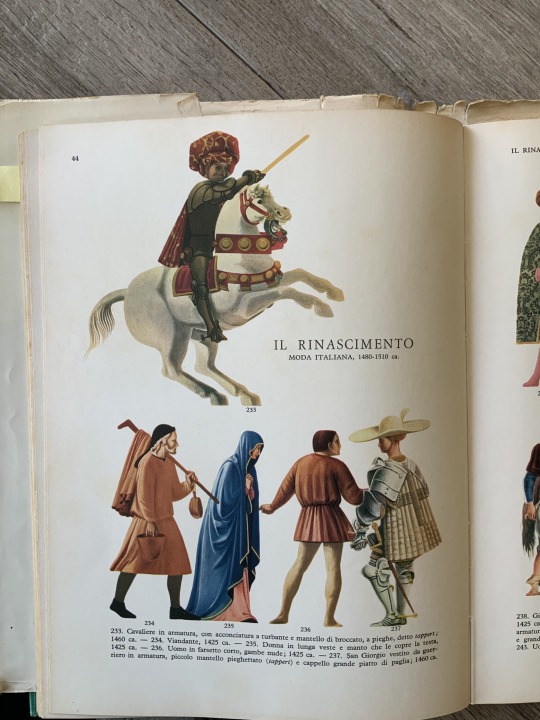
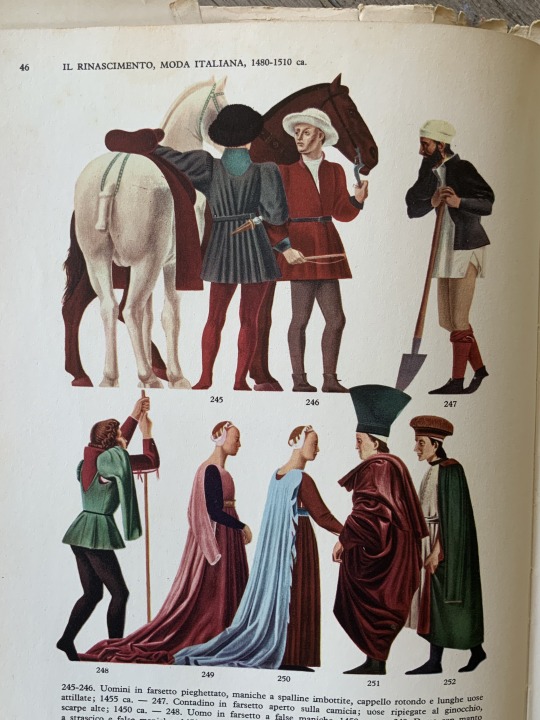
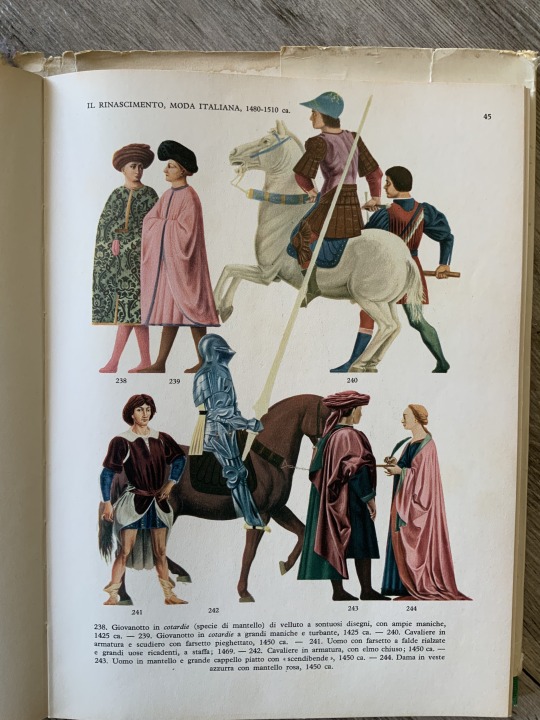


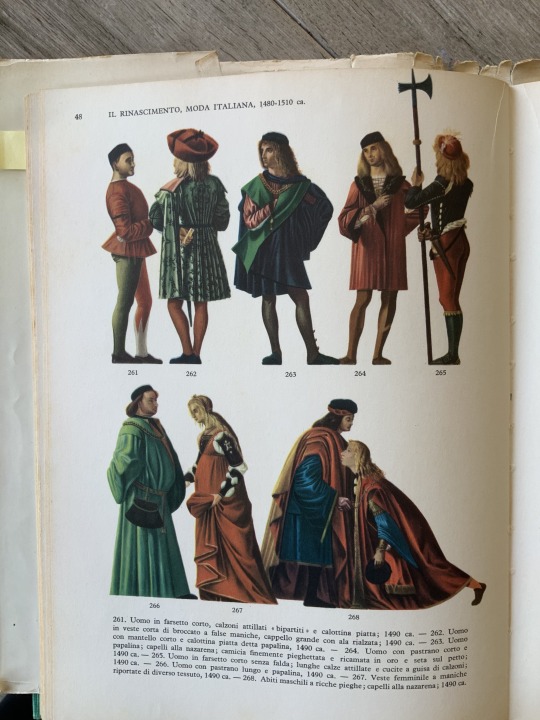
German:
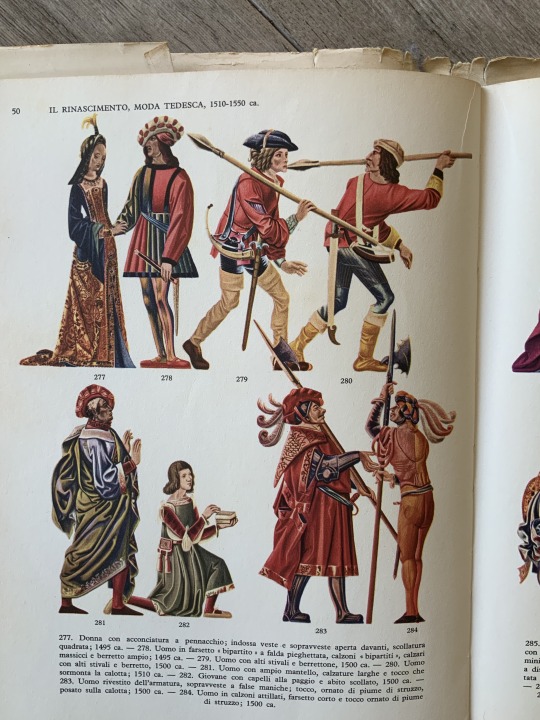




Spanish:
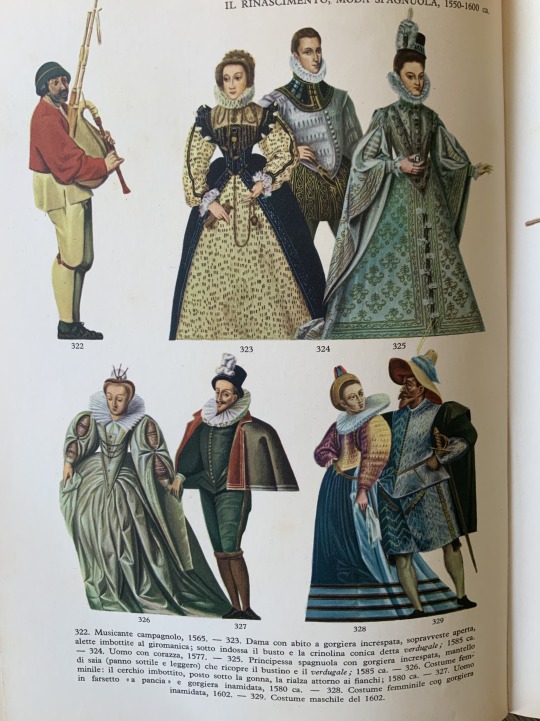
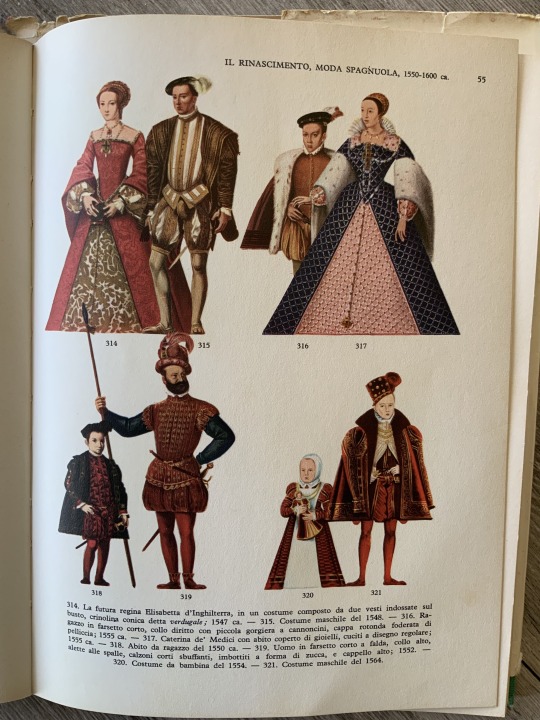

Also, IF SOMEONE READING THIS POST HAS BETTER REFERENCES, PLEASE FEEL FREE TO ADD INFORMATIONS IN THE REBLOGS! The more sources we have, the better!
Lastly, I would like to end this post by saying that despite the researches I'm more than willing to take some liberties when I draw. I'm an artist and not an historian, and whenever I feel like I'm limited by the lack of references I don't dwell too much on it and prioritize the completeness of the drawing by adding things from my mind, so don't rely too much on my art if you are looking for historical accuracy!
And that's all it comes to my mind about the topic. I hope I have been helpful (and clear, I know I still have some problems with the English language 🥲)! Thank you so much for the question and have a lovely day <3
1 note
·
View note
Photo
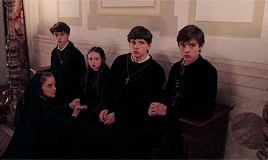

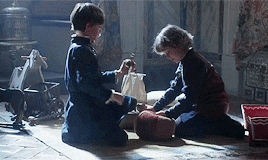

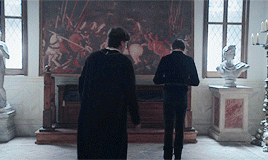
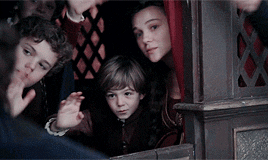



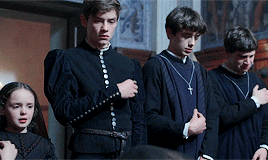
hold each other tight.
#mediciedit#perioddramaedit#medici#piero di lorenzo de medici#giulio de medici#giovanni de medici#maddalena de medici#medici: the beauty and the power#medici spoilers#mine#i love my kids so much i'm weeping#i had to scrape the barrel to find shots of them together which really tells u they weren't in the season enough#also the majority of these are sad moments which upsets me#Why Can't This Family Ever Have a Funky Good Time?
258 notes
·
View notes
Quote
Il ragazzo ama l'eleganza e il lusso, le belle donne, i bei cavalli e gli oggetti preziosi. Sarà una constante in tutta la sua vita questo amore per il bello. Una sera invita a cena il suo compagno di studi Giovanni de’ Medici, che è già cardinale, e lo sconvolge per la qualità e la quantità di arazzi, tappezzerie, ori e argenti presenti in casa, a tal punto che il futuro Leone X non se la sente di contraccambiare l'invito per evitare di sfigurare troppo. Il Borgia non vive di soli divertimenti e studi, poco prima de laurearsi conosce personalmente Lorenzo Il Magnifico e interviene presso la corte medicea per segnalare persone a lui gradite. Quando Lorenzo de’ Medici muore Cesare lo onora con un componimento che probabilmente ha fatto realizzare da qualche umanista della sua cerchia, dimostrando in questo modo di essere piú un principe/ambasciatore che uno studente.
Cesare Borgia: Le campagne militari del cardinale che divenne principe.
Andrea Santangelo.
#cesare borgia#giovanni de' medici#auth: andrea santangelo#~~questo amore per il bello~~#!!!!#my man would have understand me#saame ces same#but anyways#when i read more about giovanni and his papacy#i immediately thought: him and cesare must have gotten along well#bc they had very similar tastes and habits#they loved fine things and extravagance and they both seemed to prefer the nightime than daytime#so i think their days at pisa was pretty fun#and it's great that cesare got to meet lorenzo (soryo's manga comes to mind !!!)#he did seemed to have a great respect and admiration for him#wish we could see that on i medici#but i know it ain't happening s i g h
4 notes
·
View notes
Text
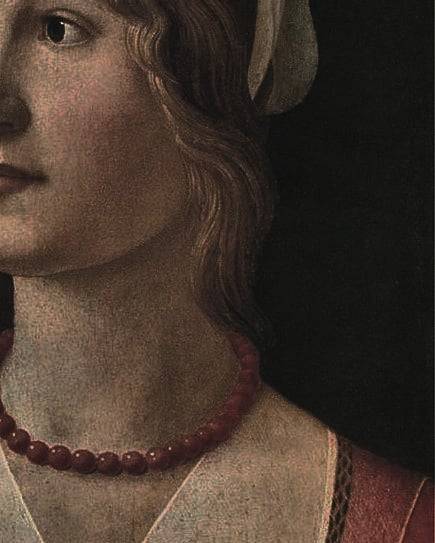
“Behind every exquisite thing that
existed, there was something tragic.”
Ginevra de' Medici nee Cavalcanti was the daughter of Giovanni Cavalcanti and Constanza di Niccolò Cavalcanti and wife of Lorenzo de' Medici , brother of Cosimo the Elder .
During a research about the house of Medici I did this summer ,my attention had been spotted by another forgotten renaissance lady, her name was :Ginevra Cavalcanti.
I also found that she had some siblings: Bartolomea Trenta, Niccolò , Giannozzo Cavalcanti and Amerigo Cavalcanti .Alas, there are not so many informations about her so we can't tell exactly about her role in the Medici family.
They say Ginevra and Lorenzo 's marriage was a happy one and they loved each other even if the marriage was an arranged one. She was the mother of Pierfrancesco de' Medici ,il Vecchio, Leonora Di Genova and Francesco de' Medici.
"In 1416, he married Ginevra Cavalcanti.To celebrate their marriage, the Venetian humanist Francesco Barbaro wrote his treatise De Re Uxoria,an analysis of marriage that continued to be published for centuries.Lorenzo and Ginevra had two sons: Francesco, who was childless, and Pierfrancesco, who originated the Popolani line. Ginevra Cavalcanti was an aunt of the wife of the famous Italian merchant Giovanni Arnolfini."
#perioddramaedit#history#edit#history edit#ginevra de medici#ginevra cavalcanti#lorenzo il vecchio#lorenzo de medici#medici#painting#florence#rinascimento#house medici#italian renaissance#mediciedit#dark acadamia aesthetic#dark academia#qab22
72 notes
·
View notes
Text
Contessina: We need to talk about your parenting skills.
Jacopo: What? Why would I need parenting skills?
Contessina: Maybe because now you’re a parent.
Jacopo: …so?
#Jacopo#Medici#I Medici#who let Jacopo be a parent?#Contessina#contessina de medici#contessina de bardi#all is fair in love and war#a medici and an orsini#i medici#medici text#text#giuliano de medici#medici#giovanni di lorenzo de medici#medici family#cosimo de medici#lorenzo the magnificent#clarice orsini#francesco pazzi#guglielmo pazzi#funny text#medici texts
41 notes
·
View notes
Text
THIS DAY IN GAY HISTORY
based on: The White Crane Institute's 'Gay Wisdom', Gay Birthdays, Gay For Today, Famous GLBT, glbt-Gay Encylopedia, Today in Gay History, Wikipedia, and more …


1433 – Born: Renaissance Humanist philosopher Marsilio Ficino (d.1499). Ficino was one of the most influential humanist philosophers of the early Italian Renaissance, an astrologer, a reviver of Neoplatonism who was in touch with every major academic thinker and writer of his day, and the first translator of Plato's complete extant works into Latin. Ficino led the Platonic Academy of Florence, a circle of literary men and artists eager to learn from the man they nicknamed "alter Plato." His large "Platonica familia" included his student Lorenzo de' Medici, philosopher Pico della Mirandola, and poets Angelo Poliziano and Giovanni Cavalcanti, Ficino's dear friend. Throughout his life Ficino also corresponded with numerous prominent men of Europe, political and religious leaders as well as scholars.
Ficino encouraged his followers at the Platonic Academy to write love letters stressing the union of souls who have lost themselves in each other. Ficino's voluminous correspondence, which was published in 1495, contains many examples of such letters, including some to Giovanni Cavalcanti.
Cavalcanti (1444-1509), a handsome Florentine nobleman, lived for many years with Ficino at his villa and was an important member of the Platonic Academy. During a brief separation in 1473-1474 Ficino wrote letters to "Giovanni amico mio perfettisimo" ("Giovanni my most perfect friend") in which he declared his love and compared their union to those of illustrious male companions of classical times.
Ficino's formulation of platonic love exercised an important influence on artists in his own time and beyond, including Michelangelo and Leonardo da Vinci. His influence can also be seen in the homoeroticism in Michelangelo's and Shakespeare's sonnets as well as in the works of Edmund Spenser, Pierre Ronsard, and Maurice Scève.
With time Ficino's concept of platonic love, clearly a relationship between men, was heterosexualized and transformed into courtly love, a reading more acceptable to society at large. It was also subsequently desexualized entirely and came to mean a non-physical love, a notion that distorts Ficino's philosophy.


1945 – Divine (d.1988), born (Harris) Glenn Milstead, was an American actor, singer and drag queen. Described by People magazine as the "Drag Queen of the Century," Divine often performed female roles in both cinema and theater and also appeared in women's clothing in musical performances. Even so, he considered himself to be a character actor and performed male roles in a number of his later films. He was often associated with independent filmmaker John Waters and starred in ten of Waters's films, usually in a leading role. Concurrent with his acting career, he also had a successful career as a disco singer during the 1980s, at one point being described as "the most successful and in-demand disco performer in the world."
Born in Baltimore, Maryland, into a conservative, wealthy middle class family, he became involved with John Waters and his acting troupe, the Dreamlanders, in the mid-1960s and starred in a number of Waters's early films such as Mondo Trasho, Multiple Maniacs, Pink Flamingos and Female Trouble. These films have since become cult classics. In the 1970s, Milstead made the transition to theater and appeared in a number of productions, including Women Behind Bars and The Neon Woman, while continuing to star in such films as Polyester, Lust in the Dust and Hairspray.
Despite some claims made to the contrary, Divine always considered himself to be male, and was not transgender or transsexual. He used the term "Divine" as his personal name, telling one interviewer that both "Divine" and "Glenn Milstead" were "both just names. Glenn is the name I was brought up with, Divine is the name I've been using for the past twenty-three years. I guess it's always Glenn and it's always Divine. Do you mean the character Divine or the person Divine? You see, it gets very complicated. There's the Divine you're talking to now and there's the character Divine, which is just something I do to make a living. She doesn't really exist at all." At one point he had the name "Divine" officially recognized, as it appeared on his passport, and in keeping with his personal use of the name, his close friends nicknamed him "Divi".
Divine was homosexual, and during the 1980s had an extended relationship with a married man named Lee, who accompanied him almost everywhere that he went. They later separated, and Divine would go on to have a brief affair with the gay porn star Leo Ford, something that was widely written and gossiped about in the gay press. Divine would also regularly engage in sexual activities with young men that he would meet whilst performing, sometimes becoming infatuated with them: in one case, he met a young man in Israel who he slept with and subsequently wanted to bring back to the United States, something that his manager prevented him from doing.
Divine initially avoided informing the media about his sexuality, even when questioned by interviewers, and would sometimes hint that he was bisexual, but in the latter part of the 1980s decided to change this attitude, and began being open about his homosexuality. Nonetheless, he avoided getting into discussions regarding gay rights, partially at the advice of his manager, realising that it would have had a negative effect on his career.
Divine and his stage act proved particularly popular amongst gay audiences, and he appeared at some of the world's biggest gay clubs, such as Heaven in London. According to Divine's manager, Bernard Jay, this was "not because Divine happened to be a gay person himself ... but because it was the gay community that openly and proudly identified with the determination of the female character Divine".
On the evening of March 7, 1988, a week after Hairspray was released, Divine was staying at the Regency Hotel in Los Angeles. The next day, he was scheduled to film his part in the Fox network's television series Married... with Children. After dining with friends and returning to the hotel, he died in his sleep of an enlarged heart at age 42.


1968 – Blake Harper, born Peter Tiefenbach, in Windsor, Ontario, a former male nurse, became a porn star. He has shot over 60 pornographic gay films.
Harper was a registered nurse since 1989 and worked as such until a scout offered to set up a meeting with Steven Scarborough of Hot House Entertainment. Scarborough offered to shoot him in a gay adult film. He eventually appeared in around 60 gay adult films in a span of 7 years.
In 2006, he won an award for "Best Performer" at the Young Erotic Gay Video Awards known in the industry as the Grabbys. He also won the 2001 GayVN Award for "Gay Performer of the Year".
The 2004 documentary Naked Fame directed by Christopher Long is about Harper's ex-lover, another porn star, Colton Ford pursuing a career in the dance music industry while in a relationship with Harper. It also shows how Harper retires from adult films and returns to his original profession as a nurse in a bid to support his boyfriend and former porn star Colton Ford in his new music career. Colton also wrote "Love Has Found a Way" which is about his relationship with Harper
According to Ford, the two have split and Harper has moved back to Windsor and works as a nurse at a local hospital.


1930 – Henry van Ameringen, a low-key philanthropist, was an early and major donor to L.G.B.T.Q. and AIDS causes. (d.2020)
Henry Pfaltz van Ameringen was born in South Orange, N.J. His father, Arnold Louis van Ameringen, was a founder of International Flavors and Fragrances, a multibillion-dollar international business, noted for his longstanding support for mental health causes. His mother, Hedwig (Pfaltz) van Ameringen, who died in 1996, was known in particular for supporting the New York Philharmonic and Lincoln Center for the Performing Arts.In a rare interview in 2010, Mr. van Ameringen spoke of his coming of age in repressive times. “I knew very early that I was gay, so it was very uncomfortable growing up,” he said. “I don’t really have very happy memories.”
After graduating from the Georgetown University School of Foreign Service, he lived in Paris for several decades. He went into the family business and retired as European vice president for fragrance marketing.
In addition to participating in his family’s foundation, Mr. van Ameringen formed his own in 1967, the H. van Ameringen Foundation. When AIDS began to devastate the gay community, he donated to organizations that responded to the crisis.
Van Ameringen and business partner and husband T. Eric Galloway created the Lantern Organization, the Galvan Group, and the Galvan Initiatives Foundation which purchased properties in Hudson, New York, where Galloway owns a part-time residence. As of 2015, the Galvan Initiatives Foundation owned 60 parcels of land in the city with an assessed value of more than $12 million.
Mr. van Ameringen, whose father made a fortune in the fragrances business, gave away some $200 million, and was among the first openly gay major donors to fund L.G.B.T.Q. and AIDS-related organizations, both large and small, at a time before they enjoyed more mainstream support.
But Mr. van Ameringen wasn’t just a check writer, especially early in his philanthropic career. At God’s Love We Deliver, an organization founded in 1986 to bring meals to people living with AIDS in Manhattan, it was not uncommon to see him in an apron in the kitchen, or delivering meals.

1999 – A rape center organization in Vancouver was ordered to pay $2,030 in damages for banning a transgendered person from its drop-in center.


6 notes
·
View notes
Text
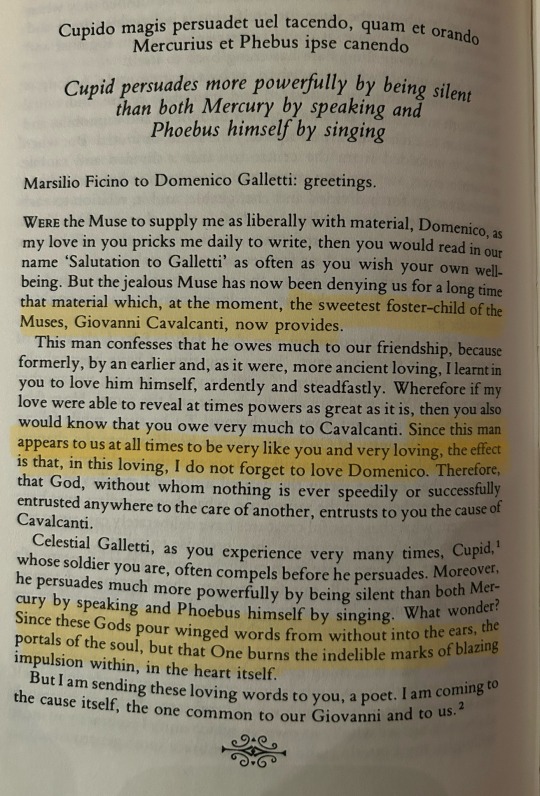
Not sure when this letter is dated—1470s would be my guess. Galletti is the one who first introduced Giovanni and Marsilio to one another.
Love that Marsilio is just like “I LOVE Giovanni So Much. …,, don’t worry, I still love you too Domenico! I promise!”
“Foster child of the Muses” as a fun opposite to the Pope’s hilarious condemnation of Lorenzo de Medici as “The child of iniquity and the nursling/foster child of perdition”.
#this gives strong: we love each other will you be the best man#vibes#at the same time there’s the: don’t worry I still love you#but Ficino loved everyone and was always assuring the entire world that he loved them#marsilio ficino#Giovanni cavalcanti#history#Renaissance Italy#Renaissance Florence#15th century#early modern Italy#early modern Florence
8 notes
·
View notes
Text

( borgia 001 ) ☩ per te è la gloria. piermaria borgia has arrived in florence from rome, resembling matteo martari. i have heard talk he is philanthropic & intrepid, so long as you overlook that he is also machiavellian & ruthless. they’re a member of the borgia family, but, in this unholy city, is blood truly thicker than water? one day they might realize their ambition to remove the colonna family from power, but only time will tell… e il regno. ☩ as written by di; est, she/her, 21.
name: piermaria borgia
age / d.o.b.: 36, 9 september 1442
birth order: eldest.
house: borgia.
place of origin: rome.
sexuality: ambiguous.
horoscope: virgo.
physique / height: slender, tall, muscular, 6'2.
faceclaim: matteo martari.
virtues: protective, philanthropic, astute, calculated.
vices: ruthless, machiavellian, unyielding, coldblooded.
relationship status: married (maddalena de medici)
children: ippolita borgia, giovanni borgia, others
religion: roman catholic.
Piermaria Borgia was born into a Rome red with blood and pale with passion at white-heat; steel, velvet, vivid colour; dazzling light and impenetrable shadow. While ushered into a world where the Borgia name was no more than a footnote in Papal documents, the next few decades would witness an unparalleled mount of power for the Borgia family; their kin would ultimately rise to the peak of the Vatican society, with one of their own, Pope Pius –– born Gioffre Borgia –– gracing the throne of Saint Peter. Since his birth, the Borgia dynasty has given two popes and one saint to the Church of Rome, although their influence and benefaction has pervaded far deeper into the underbelly of the city. While he strayed from the obligations of the church, Piermaria’s determination proved in line with the family values: described as elegant, courtly, choicely elegant, although deeply private, steely, deliberately discreet, and –– at times –– dangerously self-important.
From an early age disillusioned by power although no less motivated to seize it as a result, Piermaria developed an aversion to his father and mother; whilst protective of his siblings and primarily impelled by the desire to not only keep them safe but in similar positions of comfort and prestige, he was an isolated child –– who grew into an isolated individual. It is rare for Piermaria to allow others entrance into his personal reflections, and very few can boast of actually knowing the man behind the tightly-wound facade he maintains in the public gaze.
In the pursuit of pushing his family’s interests, Piermaria has garnered an unprecedented amount of enemies: the patricians who consider the Borgias upstarts, the clergy who considers them sinful, the ancient families of the Roman empire who would stop at nothing to see them six feet under. Many in Rome would consider Piermaria Borgia the city’s staple villain –– foul rumors fly around his history, despicable tales of despicable acts. There is little he has not been accused of, consigned to history’s most wanted list by virtue of his enemies’ wicked pens, although in actuality Piermaria is an incredibly philanthropic individual. Much of the construction surrounding the Borgia’s residence in the city is thanks to his pockets, and much of the advancement of art and culture within his purview is due to his patronage; if there is one love for him, it is Rome, and only Rome.
Piermaria’s devotion and loyalty to the Medici family, to whom he is married into, is… questionable. He is wed to Maddelena de Medici, and together they have two children (born in two years…) christened Ippolita Borgia and Giovanni Borgia. However, Piermaria also has at least three other children born out of wedlock who he recognizes loosely and will use as pawns if necessary. He is not a consummate father, preferring to take a traditional hands-off approach, although he does seek to gain titles for his children and it is through his constant advocacy on their behalf that he ultimately shows his devotion.
6 notes
·
View notes
Text
Tag drop: Connections / etc.
#⌈♱⌋ family. justice. honor. these are my values now father. as they were once yours. [ giovanni auditore. ]#⌈♱⌋ go my son. destroy them. but remember for whom we assassins fight. [ maria auditore. ]#⌈♱⌋ it is a good life we lead brother. may it never change. and may it never change us. [ federico auditore. ]#⌈♱⌋ she bears the bravery of a true auditore. [ claudia auditore. ]#⌈♱⌋ she will remember you as i will. fratellino. [ petruccio auditore. ]#⌈♱⌋ i prefer to fight like a man to filling out balance sheets. [ mario auditore. ]#⌈♱⌋ love binds our order together. love of people. of cultures. of the world. fight to preserve that which inspires hope. [ brotherhood. ]#⌈♱⌋ they recognize there is no such thing as absolute truth. or if there is. we are hopelessly underequipped to recognize it. [ templars. ]#⌈♱⌋ all of her kind died many years ago. i wish I could show you the magic she performed. [ first civilization. ]#⌈♱⌋ better in the hands of the earth than in the hands of man. [ eden / of eden. ]#⌈♱⌋ the assassins were his life. from beginning to end. he had no other. [ altaïr. ]#⌈♱⌋ your name lingers in my mind. like an image from an old dream. [ desmond. ]#⌈♱⌋ i wasn't ready! i was planning on being really charming and funny. can i just have a second chance? [ cristina vespucci. ]#⌈♱⌋ forgive me. it is a joy to see someone with a passion so personal and noble. it is inspiring. [ sofia sartor. ]#⌈♱⌋ that woman is as powerful and dangerous as she is young and beautiful. [ caterina sforza. ]#⌈♱⌋ hey i remember you. you never did apologize for knocking me over. [ rosa. ]#⌈♱⌋ so began a long and prosperous relationship between two families. yours and mine. [ de' medici. ]#⌈♱⌋ may you find great adventure as you lie and dream. and if you're scared of the darkness. i will calm your fear. [ caterina de' medici. ]#⌈♱⌋ i am a man of peace. yes. but ideas take precedence. [ leonardo da vinci. ]#⌈♱⌋ he may not please all tastes. but he is an assassin. i trust him. [ niccolo machiavelli. ]#⌈♱⌋ who is there mentor here ezio? i'm beginning to wonder. [ yusuf tazim. ]#⌈♱⌋ the world is a tapestry of many colours and patterns. a just leader would celebrate this. not seek to unravel it. [ suleiman i. ]#⌈♱⌋ it is my business to know everything in this city. [ la volpe. ]#⌈♱⌋ nobility comes from fighting beside your soldiers. [ bartolomeo d'alviano. ]
0 notes